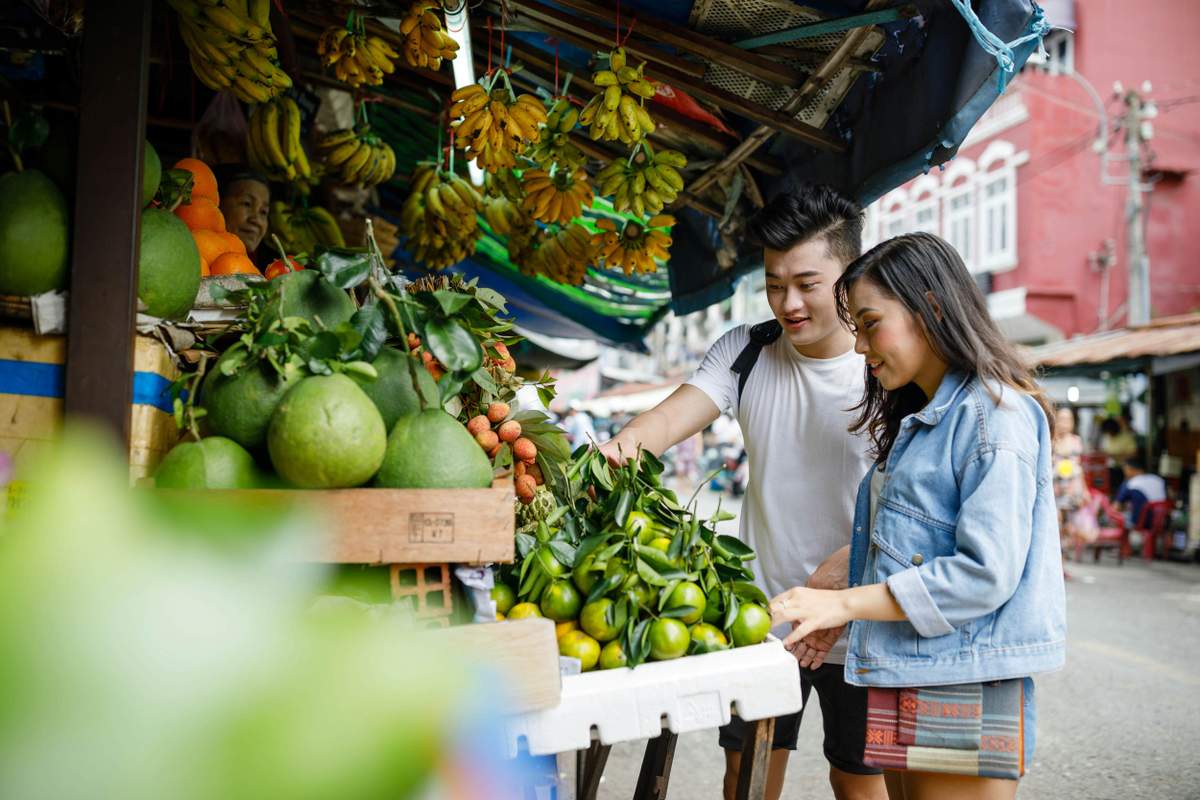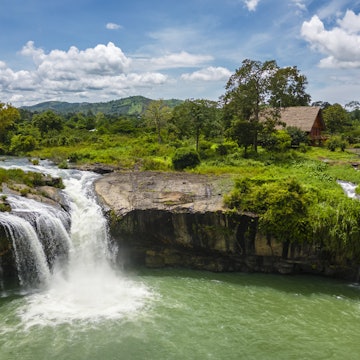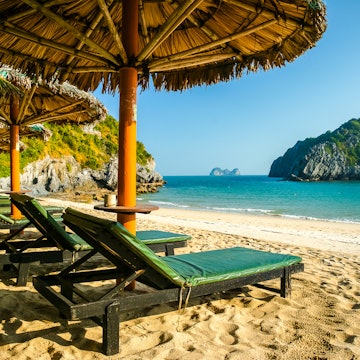

Diving from a boat into Halong Bay, Vietnam. Helena And Laurent Martin/Stocksy United
In the Vietnam’s northeast corner, extraordinary Halong Bay is home to over 1900 towering limestone islands and islets spread across 1500 sq km of the emerald-green Tonkin Gulf.
In Vietnamese, “halong” means “descending dragon”: according to legend, the Jade Emperor sent the Mother Dragon and her offspring to aid the Vietnamese people in a battle against foreign invaders. The creatures stayed, taking the form of jungle-clad islands.
Today, this UNESCO World Heritage Site is a must-see destination for its otherworldly beauty, with caves, beaches and range of outdoor activities, all just a few hours from Hanoi. Here’s what you need to know before you set out for Halong Bay.

When should I go to Halong Bay?
Halong Bay’s scenery changes with the seasons, and there is beauty to be found here year-round. There are two main seasons: winter, from November to March, with average temperatures ranging from 15–20ºC (59–68ºF); and summer, from May to September, with balmy temperatures from 25–30ºC (77–86ºF). June to August are the wettest months.
For adventurers, summer is ideal for water sports, including kayaking and swimming. The colorful Carnaval Ha Long is also held at the end of April or early May. Photographers might prefer visiting in winter, as early mornings regularly see misty conditions, creating eerie scenes of fog-shrouded islands in the distance.
How much time should I spend in Halong Bay?
Most travelers come to Halong Bay to cruise. Those pressed for time can join are half- and full-day trips that provide a very brief glimpse of the islands. (Note that this makes for a long day indeed when you include transport to and from Hanoi.)
Most travelers will opt for an overnight cruise, with transport from Hanoi leaving early morning and embarkation at around noon, dropping visitors back to the pier at the same time the next day. Typical activities on an overnight cruise can include touring a cave; visiting a beach or floating pearl farm; an on-board cooking demonstration; and squid fishing at night. Such a packed itinerary can make some cruises feel rushed, with very little time to simply sit, relax and enjoy the incredible views. While these cruises are the most popular option for visitors, the drawback is that most boats will travel along the same route, stopping at the same stops at roughly the same time – and generating crowds.
To break away from the pack, seriously consider a cruise of two or more nights. This greatly increases your itinerary options, allowing the boat to travel further into the bay (or even into neighboring Bai Tu Long Bay or Lan Ha Bay) with leisurely stops at floating villages, secluded beaches and less-touristed sites. As a bonus, there are usually fewer guests on these multi-night cruises.
If time is your friend, consider adding a day or two in the seaside city of Halong, which is developing nicely into a tourist destination in its own right.

How do I choose the right cruise?
There are some 300 overnight boats that ply the waters around Halong Bay, so travelers are spoiled for choice at every price point.
You should first determine whether you’re able to cruise for more than one night. Believe us when we say that a longer cruise leaves a completely different (and much more favorable) impression of Halong Bay. You’ll then want to select your ship, which could range from no-frills to 5-star luxury (and all the amenities you could dream of).
Be sure to ask whether the cruise price includes transportation to and from Hanoi. Additionally, if being on the ship you selected is important to you, book directly with the cruise company instead of through a tour operator – third parties have been known to switch guests to different boats without notice to meet passenger minimums.
Many cruise companies also operate on a charter basis. If you’re traveling in a group of at least 8–10 people, it’s worth looking into companies like Bhaya Cruises.
Day cruises can be booked directly with cruise companies, or travelers can show up at the Halong International Cruise Port to buy tickets. Prices start around 440,000 Vietnamese dong for a very basic boat; a fare of 1,200,000d gets you lunch, a guide and better onboard amenities.
Is it easy to get in and around Halong Bay?
Since it’s a major tourist destination, Halong Bay is very easy to get to. From Hanoi (170km away), you can go by shuttle bus (typically provided by the cruise lines), private car or even public bus, with an average travel time of about 2 hours if taking the Hanoi–Haiphong Expressway. Halong City is also served by the Van Don International Airport, located about 50km away, with flights to several major Vietnamese cities.
For those with deeper pockets, Hai Au Aviation offers flights between Halong Bay and Hanoi aboard 12-seater Cessna amphibious airplanes, including a short scenic flight above the islands (see below).
Top things to do in Halong Bay

Take a scenic flight over the bay
From water level, the islands are impressive, with their unique formations and imaginative names like Fighting Cock, Calf’s Head, Stone Dog and Incense Burner (the last is featured on the back of the Vietnamese 200,000d note). But for a completely different perspective, a 25-minute scenic seaplane flight will make the islands look like mini mountain ranges snaking through the sea. The water landings and take-offs alone are almost worth the money.
Get a bird’s eye view of Halong Bay on a cable-car ride
Alternatively, the Queen Cable Car is a great way to get panoramic views of Halong Bay and Halong City from above. Part of the Sun World Halong complex, the cable car can fit a record-breaking 230 passengers per cabin. It travels between the two halves of Halong City, with Sun World’s Amusement Complex on one side and Ba Deo Hill on the other, with lots of outdoor games and theme park activities on either end.

Explore Halong City
More than the gateway to Halong Bay, Halong City has its fair share of tourist attractions. Hike up to the 200m-high viewpoint on Bai Tho Mountain for sweeping views. Originally called Truyen Dang (meaning “lightning”), the mountain was home to an important guard post thousands of years ago, whose task was to light the way for boats on the bay. Families will enjoy the Sun World Halong theme park, with games, roller coasters, a Ferris wheel, and one of the largest water parks in Southeast Asia. There’s also the excellent Quang Ninh Museum and Library, a collection of artworks and natural object in an arthictecturally distinctive building, and a fun night market inside the Halong Marine Plaza.
My favorite things to do in Halong Bay
Other than cruising (which is a bucket-list experience), there is so much to do on the Halong Bay’s shores. One of my favorite places to relax is at the Japanese-style Yoko Onsen Quang Hanh, about 15 minutes from Halong. Surrounded by mountains and forests, this onsen is known for its natural, mineral-rich water. As a bonus, the experience costs a fraction of what a comparable visit would be in Japan.
I also love sampling regional specialties like bun cu ky (stone crab soup): rice vermicelli, tomatoes and fresh herbs in a fragrant broth, all topped with the meat from stone crabs found in the mangroves around Halong Bay. Try it at Nha Hang Thanh Loc or at Bun cu ky Ba Lan at Bai Chay Beach. Other favorites include grilled squid; and Halong-style squid cakes, which are made of minced squid formed into chewy patties and deep-fried. They can be eaten as a snack or with steamed rice-flour crepes as a meal.
What should I pack for Halong Bay?
If traveling in summer aboard a cruise, you won’t want to forget your swimsuit. Some of the islands have caves or viewpoints, so sturdy shoes are recommended. At other times of the year, evenings and early mornings can be chilly, so bring a light jacket.

How much money do I need for Halong Bay?
Most travelers to Halong Bay will be on a package cruise, with the benefit of all-in-one pricing covering accommodation, food and activities. Extras (spa, kayaking and alcohol) can be paid for by credit card on most cruises. Bring cash for tips and for restaurant meals if exploring Halong City.
4-hour join-in day cruise: from 440,000d
One-night cruise aboard a 3-star boat: 3,500,000d per person
Basic hotel room in Halong City: 500,000d
Bowl of cu ky crab noodle soup: 50,000d
Average cruise tip per person, per night on a basic boat: 100,000d
25-minute scenic seaplane flight: 2,400,000d
Queen Cable car ride: 300,000d
















